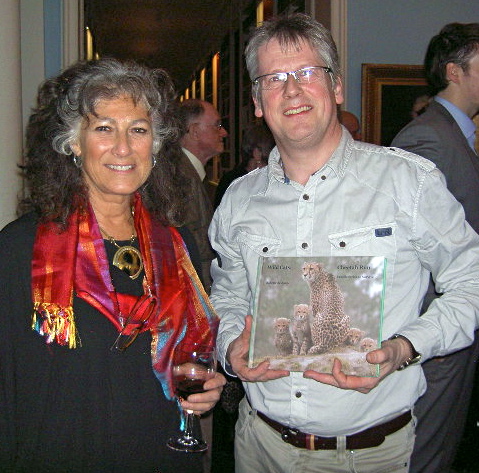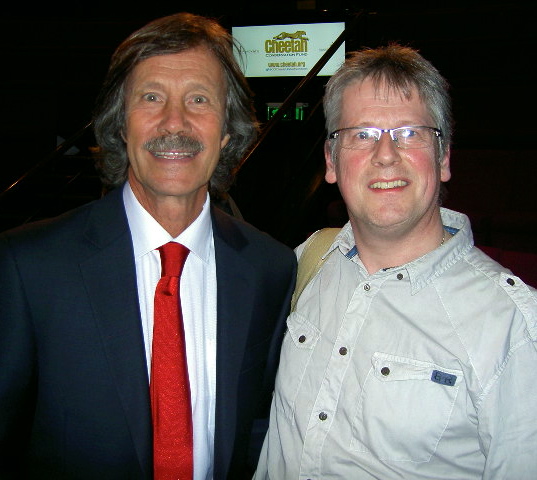What is WCW? A non-profit foundation, based and registered in Holland (Europe). Who is WCW? Basically WCW is just one person, founder/director Babette de Jonge, idealistic wild cats enthusiast for ages (for background scroll down), started the foundation in 2010 together with Eva Julia Christiie, a Norwegian illusionist. This cooperation lasted for just a few months. Babette wanted to believe they shared the best interest for the wild cat species, so that together they would not only rescue the tigers Eva was working with, from a life in circus and small/unnatural environment as they intended to, but also to give the best of welfare to many other abused wild cats, and at the same time contribute to conservation of the wild species. This is still the mission of Wild Cats World.
Babette worked on alone and lifted the foundation WCW up to the current standard and has still been pursuing her dreams and passion to do what’s best for the wild cats, in captivity and in the wild. The past few years amazingly backed up by her boyfriend Anton Buijen van Weelden (also: Wild Cats Films), in spirit and sponsoring, who shares the same passion. In South Africa, Indonesia & Nepal associations, alliances/ partners are working closely with Wild Cats World on ground level, like Spotted Cats Conservation, Felidae Centre, Cat Conservation Trust, Wanicare Foundation and Jane Goodall Institute Nepal. These associations are essential for the work WCW has in mind for both captive and wild species, as well as the work in education, raising awareness, releasing some cats back to their natural habitat.
Without the ever growing network world-wide the foundation would be nowhere, but still stamina, fighting spirit and everlasting passion and love for the animals is most important, as well as to be able to give more than to get. And that includes the huge investments financially you have to keep on doing. Babette: “I am afraid I have to destroy the dream of many, thinking in this line of business you can do what you love best and earn a lot of money with it at the same time. Well: NO WAY! Not if you do it with the right intentions: welfare of the animals. Meaning: no exploitation, trading and hunting businesses but a true conservation project!
We every now and then try to do some fund raising but it more than ever is a failure, as sadly most people do talk with no action (to judge is always the easiest way) but also because the bigger organizations and fake ones all the same, spoil it for the good ones. So apart from a few loyal “wild cats fans” who truly want to do something for the cats even though they often haven’t got much to spend either, and to whom we are very grateful, most of the investments are done by ourselves. Meaning: working your butt off, in several jobs outside the “conservation business”, and investing all we can in the projects and animals.
Conservation projects aren’t for free…. just for a start up capital you need around 1 million euro, and it keeps going. Also for a release program like we are working on with Wanicare foundation & Cikananga Wildlife Sanctuary, lots of expenses as nothing is for free: capture program, stay in captivity, habitat research, transport expenses, camera traps, collars & equipment, release cage, etc. etc. No support as promised by the government so every step of the way our foundation needs to see that the expenses are being dealt with. Also of the captive projects, WCW is only investing and not earning any money. Idealistic: yes? The right way? Yes, but only if you have a true heart for the animals, your projects and truly believe in your mission.
Of course our opinion and mission changes a bit from time to time in order to stay realistic and make things possible. Also mistakes are made on the way. Usually this involves: trusting the wrong humans/associations. You hope the people you intend to work with are having the same thoughts and passion, but sadly this often isn’t the case. Many people are in conservation for the wrong reasons. Besides, lots of envy and backstabbing…. and competition. Where we think projects and organizations with the same mission need to work together, it usually works the other way round. Lots of new projects want to do the same as WCW…. and wish only our projects will end up a failure out of envy, but as we said: stamina, etc. is the only way to survive in conservation, as well as trying to find the right people and projects to work with. All donations and sponsor money will go directly in the projects. People who have no trust can choose to which project they want to donate to, and they can follow their “investment” closely on ground level.”
Some background info about Babette de Jonge.
Already from an early age (8) Babette was taking care of animals (firstly pets of course, essential for a future in wild cat(s) care) and interested in welfare organizations focusing on animals. First starting biology/ethology, tiger (clicker) training, etc. workshops, observation/photography in zoos/sanctuaries and natural habitat of the cats, Wild Cats Magazine was founded, for education and raising awareness of all the species and issues concerning them.
Babette organized “Wild Cats” photography trips to Masai Mara/Kenya and India for the tigers for a few years, gave lectures, wrote and still is writing articles for several magazines, websites and this year the first few “Wild Cats” books were released with text/photography by Babette. Volunteering in some sanctuaries was essential for the knowledge how to work best with the wild cats, big and small, and to learn how not to do it in the WCW projects.
After all great experiences, the biggest challenge for Babette is to keep on learning about the cats and how to do the work with/for them and in the projects the best. “They keep on surprising me and that is for me the biggest joy, apart from the fact that it is so rewarding to invest in a project and see how the cats are thriving because of your ideas and input. It is difficult to find the right balance between captivity and the wild. Of course our priority will always be the wild animals and to keep them safe in their natural habitat, but there’s also lots of captive born cats that cannot be released anymore. It maybe is wrong to (sometimes) buy them to get them out of the wrong hands but it is not all black and white.
We believe that what we are doing is the right thing and we will never do anything to harm an animal. We observe them and will think of a way to make the situation as good as possible. By giving them lots of natural space or whenever possible (our aim) to do some re-wilding and releases back into natural habitat.
It is sad that there’s so much envy and that people so easily judge on what you do, but we have to remember that we at least do something and usually the ones to judge are not doing more than sitting behind the computer safely at home. It would be great though if more organizations will see each other as associations and not as competitors, but then I will always be an idealistic person!” More info needed? Please contact us here or on our website WildCatsWorld.org.





